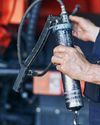TASK-BASED TRAINING INSPECTING A DESICCANT BREATHER
MACHINERY LUBRICATION INDIA
|September - October 2023
Contamination Control
-

WHAT IS A DESICCANT BREATHER?
Desiccant breathers are used to dehumidify incoming air and the headspace of equipment, while also restricting the ingression of small particulates.
WHY USE A DESICCANT BREATHER?
Many machine failure modes are associated with contaminants that breathers help to control. Most equipment comes equipped with a breather that is not sufficient. These OEM breathers will do little to nothing to reduce the ingress of particles and moisture, and they need to be replaced with something better.

WHY INSPECT A DESICCANT BREATHER?
These breathers eventually go bad - they aren't intended to last forever. They become saturated with moisture and lose their effectiveness; they can become clogged, restricting air flow and preventing the machine from breathing. If we're doing inspections well, we can have early warning signs of impending machine problems.
WHAT ARE SOME OF THE STYLES OF BREATHERS?
The OEM breather will likely look something like Figure 1: These do very little in terms of contaminant restriction - they do nothing for moisture and only prevent the ingression of very large particles; we are more concerned with fine particles.
Next, we have passive-style breathers (See Figure 2). In this sense, passive means the breather is open and breathing at all times: it will allow air in and out, and it is cleaning and dehumidifying the entire time. Next are check valve breathers (See Figure 3).
Unlike the passive, open-all-the-time breathers, these breathers feature check valves that keep the breather sealed until it needs to breathe. This style of breather also comes equipped with a pressure gauge that indi-
Esta historia es de la edición September - October 2023 de MACHINERY LUBRICATION INDIA.
Suscríbete a Magzter GOLD para acceder a miles de historias premium seleccionadas y a más de 9000 revistas y periódicos.
¿Ya eres suscriptor? Iniciar sesión
MÁS HISTORIAS DE MACHINERY LUBRICATION INDIA

MACHINERY LUBRICATION INDIA
PREDICT OIL USEFUL LIFE WITH REAL-TIME DATA
Oil is the life of any hydraulic or lubrication system.
8 mins
November – December, 2025

MACHINERY LUBRICATION INDIA
HOW THE RIGHT LUBRICATION TOOLS AND HARDWARE INFLUENCE MACHINE RELIABILITY
Having spent a good portion of my career around heavy machinery, both in the military and later in the civilian world, I’ve come to realize one critical fact: the tools you use matter just as much as the skills you have.
4 mins
November – December, 2025

MACHINERY LUBRICATION INDIA
Unlocking the Power of Oil Analysis & Particle Counting
Lubrication practices ensure peak performance and longev ity in machinery maintenance.
4 mins
November – December, 2025

MACHINERY LUBRICATION INDIA
BEYOND THE LABEL: UNDERSTANDING LUBRICANT TECHNICAL AND SAFETY DATA SHEETS
Over the years in lubrication, I have noticed that many professionals either overlook or misinterpret lubricant datasheets, especially Product Datasheets (PDS), which are key to selecting the proper lubricant. While Safety Datasheets (SDS) are widely known due to compliance requirements, the PDS holds the technical insights needed for informed decision-making. Yet, it is often misunderstood or ignored.
3 mins
November – December, 2025

MACHINERY LUBRICATION INDIA
SMART FILTRATION IN HEAVY INDUSTRIES:
PROTECTING WORKERS IN CEMENT AND STEEL MANUFACTURING
5 mins
November – December, 2025

MACHINERY LUBRICATION INDIA
IOCL & INFINEUM FORGE STRATEGIC LUBRICANT PARTNERSHIP
Infineum India and Indian Oil Corporation Limited (IOCL) have signed a strategic Memorandum of Understanding (MoU) aimed at deepening their collaboration to unlock long-term business value and drive innovation in India's mobility sector. The agreement was formalized at IOCL's Mumbai office, with Bakim Patra, Executive Director (Lubes) at IOCL, and Harshad Jambaulikar, General Manager of Infineum India, as the principal signatories.
1 min
November – December, 2025

MACHINERY LUBRICATION INDIA
CONTAMINATION REALIZATION: A CASE EXAMPLE AT A STEEL MILL
Condition monitoring, contamination control, lubrication excellence, and machine reliability are keywords that are often overused and misunderstood.
6 mins
November – December, 2025

MACHINERY LUBRICATION INDIA
BREAKING DOWN THE BASICS: A LESSON IN ASSET RELIABILITY
Before you go marching down to your reliability engineers and ask questions like, “What are the top 10 worst performing assets in our production line?”, it’s important to know the actual difference between an asset and reliability.
7 mins
November – December, 2025

MACHINERY LUBRICATION INDIA
EFFECTIVE USE OF THE PATCH TEST FOR SIMPLE ON-SITE ANALYSIS
The very best oil analysis programs incorporate some degree of onsite analysis. For most plants, mills, and mines, particle monitoring is the most productive onsite oil analysis activity available.
4 mins
November – December, 2025
MACHINERY LUBRICATION INDIA
CAFFEINE VS. CALM: FINDING THE RIGHT ENERGY BALANCE DURING WORK HOURS
For many of us, the workday doesn't officially begin until the first sip of coffee. In industrial and corporate settings alike, caffeine is often seen as a silent coworker, fueling early mornings, long shifts, and back-to-back meetings.
2 mins
November – December, 2025
Translate
Change font size

